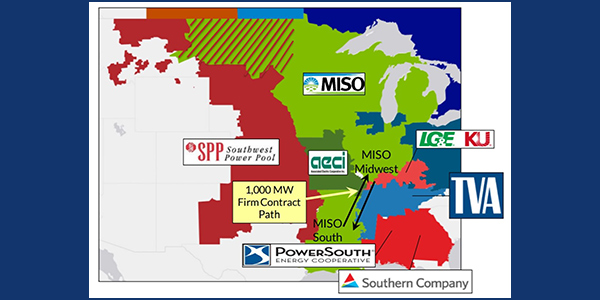Without a viable alternative on the horizon, MISO will likely extend its settlement agreement for flows on the Midwest-South subregional transmission constraint through early 2023.
“Until there’s a longer-term solution in place … the recommendation is to extend that settlement agreement until Jan. 31, 2023,” MISO Director of Seams Coordination Jeremiah Doner told stakeholders during a Market Subcommittee teleconference Thursday.
Doner said discussions with SPP and the other parties to the agreements on its future are in the early stages.
Starting Jan. 31, 2021, the settlement may be terminated by any party with a year’s notice. Without a replacement settlement, flows would be limited to MISO’s original 1,000-MW contract path in either direction. The settlement limits MISO to 3,000 MW of flows in the north-to-south direction and 2,500 MW of flows in the other.
Earlier this year, the parties signed a memorandum of understanding that they wouldn’t propose changes to the settlement until Feb. 1, 2022. Doner said an extension until 2023 will buy time for them to explore eventually changing the terms of the agreement.
Stakeholders asked if MISO would consider negotiating an increase in its transfer capability.
“I think it’s fair to say everything is on the table at this point,” Doner said, adding that MISO hasn’t ruled out a transmission project to increase transfer capability between its South and Midwest regions. After completing a special study, MISO last month said it wouldn’t recommend any upgrade to secure more transfer capability to its Board of Directors this year. (See “No Midwest-South Tx Solution this Year,” Price Tag Rising for MTEP 20.)
Doner said that while some aspects of the settlement discussions are confidential, MISO will share what it can with stakeholders in upcoming public meetings.
A two-year extension would keep in place MISO’s current cost allocation for transmission above 1,000-MW flows. MISO’s payments to the other parties for such flows are recovered from market participants through a combination of load ratio calculations and flow-based beneficiary allocations.
The load-based share declined every year since 2016 as the flow-based portion increased. From Feb. 1, 2016, to Jan. 31, 2017, the allocation was 45% load-based and 55% flow-based. From Feb. 1, 2020, to Jan. 31, 2021, the mix is 10% load-based and 90% flow-based. Doner said MISO would keep the current allocation under the extension.
Because of the declining importance of the load-based allocation, some stakeholders said MISO’s next logical step would be to use a 100% flow-based allocation through early 2023.
Doner took no position on the suggestion but noted MISO would have to win FERC approval for a Tariff revision to either change the cost allocation or pursue an extension of the current rate schedule.
“If all of the parties are good with the terms of the agreement, that settlement agreement can continue in perpetuity, essentially,” Donner said. He said the settlement also contemplates an extension of the original terms, with 2% annual cost escalations written in for use of the regional directional transfer.
However, if any changes to the settlement agreement are made before the Jan. 31, 2023, extension is up, it would trigger a requirement to also review the existing rate schedule.
Doner asked for written stakeholder comments on the extension by July 2.




